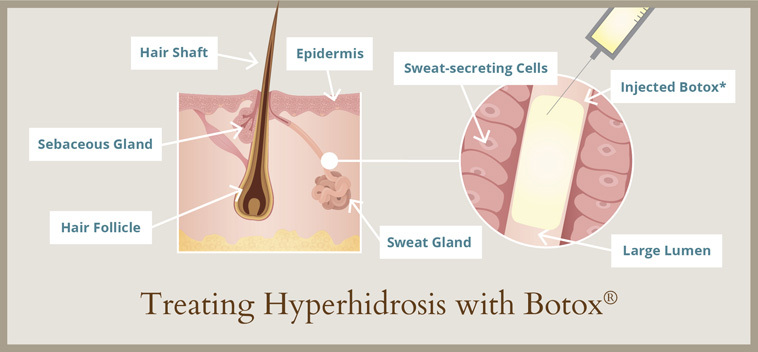Hyperhidrosis
Conditions
What is Hyperhidrosis / Excessive Sweating?
Your body produces sweat to coat the skin in an effort to cool your body when it is overheated. Everyone experiences extreme sweating during certain activities, like working out, but if you are excessively sweating during effortless activities, you may have a medical condition known as hyperhidrosis. Hyperhidrosis is the medical term for excessive perspiration due to overactive sweat glands. There are other medical conditions that can also cause abundant perspiration. Some of these conditions can be serious. It is imperative to see a doctor if your excessive sweating persists for a long period of time.
What are the symptoms of excessive sweating?
The main symptom of excessive sweating is wetness on the surface of your skin. This wetness will most likely occur in your armpits, on your face, on the palms of your hands and on the bottoms of your feet. Constant wetness may be cumbersome because it could cause skin irritation and can be visible through clothing. This condition may also cause you to become withdrawn, self-conscious or depressed from embarrassment.
What causes excessive sweating?
Sweating can be caused by several factors, like warm temperatures, exerting your body, exercising, taking certain medications and feeling embarrassed, angry or nervous. If you are still experiencing an exorbitant amount of sweating without these factors, then you likely have a genetic condition called primary hyperhidrosis, which is characterized by overactive sweat glands. Overactive sweat glands can also be the result of a more serious condition.
These conditions are considered secondary hyperhidrosis, and they include:
- Anxiety
- Menopause
- Overactive thyroid
- Cancer
- Parkinson’s disease
- Heart disease
- Diabetes
- Rheumatoid arthritis
- Pregnancy
- Fever
- Alcoholism
- Tuberculosis

How can excessive sweating be treated?
Interestingly, it has been found that Botox injections, which are normally used to treat wrinkles, can temporarily cease your sweat secretion by obstructing the nerve signal to your brain.
How does Botox® Treat Hyperhidrosis?
Botox® is formulated with botulinum toxin, a substance that is able to interfere with the transmission of signals sent to glands and muscles. Because hyperhidrosis sufferers are afflicted by overactive sweat glands, Botox® is able to provide relief by interrupting the processes that cause those glands to secrete more sweat than they should. When this process is interrupted, excess sweating is significantly reduced.
There are an enormous number of benefits that come with Botox® hyperhidrosis treatment. Aside from the general improvement in your self confidence and comfort, some of these include:
Underarms
- Not having to wear dark clothing all the time
- Clean, dry clothes that you can comfortably wear throughout the day
- Raising your hand in classes, seminars or meetings without the embarrassment of exposing damp underarms
- Freedom from the body odors that come from clothes and skin that have accumulated dry sweat throughout the day
Forehead
- Looking neat and clean by preventing sweat from dampening and displacing your hairstyle or causing makeup to run and smear
Palms
- Shaking hands with others without having to worry about sweaty palms
- Being able to write, draw or play sports without palm sweat interfering with your hand’s grasp on racquets, pens or bats
Feet
- Enjoying the feeling of dry feet and stopping foot odour caused by excessive sweating

Botox® provides complete safety, almost no recovery downtime and minimal discomfort. Most patients choose to return to their normal schedule immediately after treatment and side effects are usually limited to slight, temporary, localized bruising and swelling.
Results typically become noticeable within 48 hours. Sweating should subside to a desirable level and optimal results reached within one week following treatment. The benefits of Botox® carry on for roughly five to six months and can be maintained with follow up treatments.
